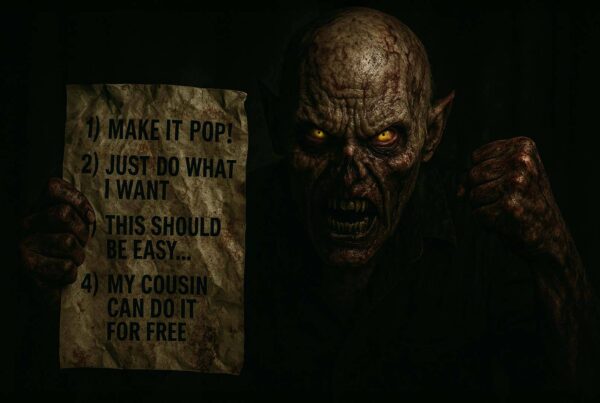Just like most designers starting out, I would just guess my prices. A client asks for a logo design and I’d think, “I can do it for $_____.” Yeah, that sounds good.” Then I would submit my price and hope to win.
In fact, everything about my business was a total guessing game. Haha. I had no idea what I was doing. Fortunately, over time, through trial and error, I solved the granular tactics that led me to building a successful agency.
Among those detailed tactics were many pricing strategies. In fact, I wrote a whole book about pricing creative services and I have a seven hour course that will empower you to increase your profits and maximize your profit.
Here are nine game changing tips to help you understand pricing dynamics in your creative business.
 1. Know Your Cost to Produce the Work
1. Know Your Cost to Produce the Work
I don’t recommend charging clients based on hours for most engagements. However, I do recommend that you estimate your cost to produce the work. No more guessing if you’ll be profitable. Estimate the number of hours it will take you to complete the a project and multiply it by your hourly rate. This number will become your floor for negotiations.
If you think a project will take you 20 hours and your hourly rate is $100 per hour (20 x $100 = $2,000), then your price to a client can be ANY NUMBER greater than $2,000 and you will be profitable. Calculate your production cost, then make sure you charge higher than that number on every project.
2. Stop Feeling Bad About High Prices
Just because you love what you do and you’re good at it should not make you feel bad about charging high prices for it. You’re running a business. You have a responsibility to the business to generate revenue and maximize profits. Your clients are doing that for their business and you should do the same. And no matter how high you might think your price is, there is someone in the world charging even more than you. Charge more.
3. Offering a Discount Is a Race to the Bottom?
“Discounting your prices is a race to the bottom,” some other mentors may authoritatively say to you. I say, “bull crap.”
The reality is discounting your price (occasionally) can make the difference between you winning or losing a project. And winning a project at a discounted rate just might give you enough money to pay your rent coming due next week. If you have a need for income, price the work where you need to price it to win the projects. You can always increase your prices once you get your life in order and your bills paid.
4. Your Prices Have to Match the Clients You’re Attracting
You can’t charge $10,000 for logos if you are attracting clients with $50 budgets. I don’t care how convincingly you express the value of your work. It doesn’t matter how masterful your objection handling skills are. If the client doesn’t have the money, they don’t have the money.
Do you want to dramatically increase your prices? Then dramatically improve your marketing. Once you look, operate, and sell like a business that merits higher prices you’ll be able to charge higher prices.
5. Money in the Bank Will Increase Your Prices
Nothing will help you charge higher prices more than having money in the bank. Money in the bank gives you power to say “no” to low priced projects and bad clients. Financial need makes us weak in business. Once you don’t “need” the money to keep the lights on and rice on the table you’ll start having the power to command higher prices with confidence.
6. Creating Demand Will Increase Your Prices
If you have five active projects and ten new leads you’re working to land, you have a surplus of “demand.” And you’re super busy so you have a shortage of “supply” (i.e. time available to take on more projects).
In contrast, if you have zero projects and only one new lead, you have a surplus of “supply” and a shortage of “demand.”
When you have a surplus of “demand” you can charge higher prices because your “supply” is more valuable.
When you have a surplus of “supply” then you might be tempted to accept projects at lower prices because you have low “demand.”
Want to increase your prices? Create a surplus and “demand.” Craft effective marketing and get out there and meet new people. Tell them what you can do to help their business. Market. Sell. Market. Sell. Increase demand.
7. You Don’t Want to Win Every Project
Start tracking how many opportunities you win versus how many you lose. You don’t want to win every project!
If you win 10 out of 10 projects at $3,500, you’ll generate $35,000 in revenue.
If you win 7 out of 10 projects at a projects at $5,000, you’ll generate $35,000 in revenue with 30% less work!
Start tracking your win/loss record. Target a win rate of 50-70%. If you’re winning more than that, you need to increase your prices. (If you’re winning less than that, you need to fix your marketing and sales processes.)
 8. It Might Be Too Much Money for Their Business
8. It Might Be Too Much Money for Their Business
Some clients are going to haggle your price no matter what you do. These “entrepreneurs” seem to think they have to win every negotiation and steamroll you into lower prices. Frankly, I HATE that approach. Don’t be afraid to tell these discount-seeking-wantrepreneurs to go find someone cheaper.
“It seems our prices are too high for your business. You may be better off looking for a junior designer or using a ‘do it yourself’ template tool to try to get the work done. Perhaps in the future when you have more revenue to market your business properly we could consider working together.”
I like this subtle way to say, “You’re too cheap and clearly you don’t care about your business enough to pay someone at proper rates to do the work right,” without sounding like a total jerk.
Just because your price is too much for their business doesn’t mean it is too much.
9. How Much Profit Should I Include?
Stop asking yourself, “How much should I charge for this?” And start asking, “How much profit should I include in my price?”
This subtle shift in question will alter your mindset when pricing your work. As for how much profit to charge? Let’s see what the market says.
I recently read an article about the 5 most profitable companies with the highest margins in the world. Here they are:
MicroStrategy Incorporated (NASDAQ:MSTR), Profit Margin: 86.47%
VICI Properties Inc. (NYSE:VICI), Profit Margin: 69.59%
Emerson Electric (NYSE:EMR), Profit Margin: 69.33%
First Citizens BancShares, Inc. (NASDAQ:FCNCA), Profit Margin: 65.51%
Texas Pacific Land Corporation (NYSE:TPL), Profit Margin: 64.23%
These are the most profitable big businesses in all the world and those are their margins. Consider that before you start feeling bad, thinking your margins are too small.
My agency averaged 31% profit margin over 13 years before I sold. The agency I sold to was doing about 15% profit margin at the time of our merge. I’ve heard numbers ranging from 1-2% profit margin to 100%+ profit margin for creative agencies.
So, what should your target profit margin be? I’d say anywhere between 30% and 70% is a range you can feel comfortable with, considering the caveat that you can charge as much as you want with has much profit as you can get. If the client says “yes” you are not overcharging.
There are so many nuances that go into pricing work. The tips I’ve shared here are just a few mindsets and strategies that have helped me become comfortable with pricing creative work and generate ample profit in my agency. I hope they help you too.












